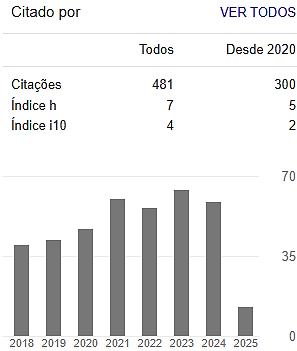ANÁLISE DA QUALIDADE DA ÁGUA SUBTERRÂNEA EM ÁREAS INDUSTRIAIS CONTAMINADAS NA UGRHI-22
Palavras-chave:
Água subterrânea; área contaminada; gerenciamento de área contaminadaResumo
A poluição de origem industrial afeta negativamente a qualidade do solo e compromete a qualidade dos meios aquáticos, os quais são responsáveis pelo abastecimento de água. O objetivo do trabalho foi analisar a qualidade da água subterrânea em áreas industriais contaminadas na UGRHI 22. Para a identificação das áreas utilizamos as informações obtidas por meio de relatórios informando a localização das áreas potencialmente contaminadas por processos de atividades industriais em todo território do estado de São Paulo pela CETESB, com essas informações definiu-se poços de monitoramento para analisar a água subterrânea. Os resultados obtidos identificaram que as áreas contaminadas seguem o Limite Quantitativo Praticável da Resolução CONAMA nº 396/08, apenas o parâmetro de Cromo na área 2, a jusante da segunda coleta foi superior. Conclui-se que medidas de recuperação já estão sendo feitas e que é devido a isso, que os valores dos resultados encontrados na pesquisa foram resultados abaixo dos limites de quantificação praticáveis estando enquadrado na resolução CONAMA n° 396/08.
Downloads
Referências
ANDRADE, J. de A.; AUGUSTO, F.; JARDIM, I. C. S. F. Biorremediação de solos contaminados por petróleo e seus derivados. Eclet. Quím., São Paulo, v. 35, n. 3, p. 17-43, Sept. 2010. https://doi.org/10.1590/S0100-46702010000300002
AVATZ. Medidas de intervenção. AVATZ AMBIENTAL. 2018. Disponívelem: <http://avatz.com.br/gerenciamento-ambiental/medidas-de-intervencao/>. Acessoem: nov. 2018.
CETESB, Companhia de Tecnologia de Saneamento. Ambiental. Relatório de Estabelecimento de Valores Orientadores para Solos e Águas Subterrâneas, São Paulo, 2001.
ECYCLE. O que é coprocessamento e quais as vantagens ambientais que ele pode oferecer?. eCycle. Disponível em: https://www.ecycle.com.br/component/content/article/67-dia-a-dia/5918-o-quee-coprocessamento-e-quais-as-vantagens-ambientais-que-ele-pode-oferecer.html>. Acesso em: nov. 2018.
HAHN, A. V.; REZENDE, I. A. C.; NOSSA, V. O seguro ambiental como mecanismo de minimização do passivo ambiental das empresas. RevistaUniversoContábil, v. 6, n. 2, p. 61-81, 2010. https://doi.org/10.4270/ruc.2010213
KRAEMER, M. E. P. Passivo Ambiental. AMDA, 2003. Disponível em: <http://www.amda.org.br/assets/files/Passivo%20Ambiental.doc>. Acesso em: mai. 2018.
NOBRE M. M. E NOBRE, C.M. Remediação de Solos. Técnicas alternativas melhoram desempenho. Química e Derivados, n° 417. 2005.
PASSARI, L. M. Z. G.; SOARES, P. K.; BRUNS, R. E.; SCARMINIO, I.S.Estatística aplicada à química: dez dúvidas comuns. Quím. Nova, São Paulo, v. 34, n. 5, p. 888-892, 2011. https://doi.org/10.1590/S0100-40422011000500028
SÁNCHEZ, L. E. Revitalização de áreas contaminadas. In: Moeri, E. Coelho, R. Marker, A. (orgs), Remediação e Revitalização de Áreas Contaminadas: aspectos técnicos, legais e financeiros. São Paulo: Signus Editora, p. 79-90, 2004.
SILVA, E. de O.; SANTIAGO, M. F.; SANTOS, B. C. dos. Manejo de Resíduos Químicos. Comissão de Gerenciamento de Riscos. Universidade Federal de Goiás. 2018.
VELLANI, C. L. Passivo ambiental e a ecoeficiência. FACEF Pesquisa Desenvolvimento e Gestão, v. 11, n. 3, 2010.

